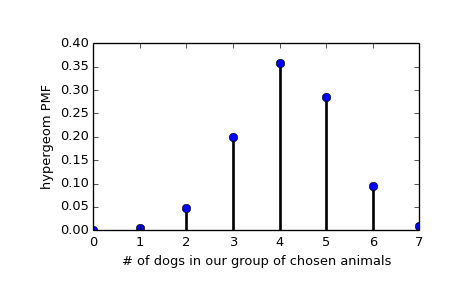scipy.stats.hypergeom¶
- scipy.stats.hypergeom = <scipy.stats._discrete_distns.hypergeom_gen object at 0x450b186c>[source]¶
A hypergeometric discrete random variable.
The hypergeometric distribution models drawing objects from a bin. M is the total number of objects, n is total number of Type I objects. The random variate represents the number of Type I objects in N drawn without replacement from the total population.
As an instance of the rv_discrete class, hypergeom object inherits from it a collection of generic methods (see below for the full list), and completes them with details specific for this particular distribution.
Notes
The probability mass function is defined as:
pmf(k, M, n, N) = choose(n, k) * choose(M - n, N - k) / choose(M, N), for max(0, N - (M-n)) <= k <= min(n, N)The probability mass function above is defined in the “standardized” form. To shift distribution use the loc parameter. Specifically, hypergeom.pmf(k, M, n, N, loc) is identically equivalent to hypergeom.pmf(k - loc, M, n, N).
Examples
>>> from scipy.stats import hypergeom >>> import matplotlib.pyplot as plt
Suppose we have a collection of 20 animals, of which 7 are dogs. Then if we want to know the probability of finding a given number of dogs if we choose at random 12 of the 20 animals, we can initialize a frozen distribution and plot the probability mass function:
>>> [M, n, N] = [20, 7, 12] >>> rv = hypergeom(M, n, N) >>> x = np.arange(0, n+1) >>> pmf_dogs = rv.pmf(x)
>>> fig = plt.figure() >>> ax = fig.add_subplot(111) >>> ax.plot(x, pmf_dogs, 'bo') >>> ax.vlines(x, 0, pmf_dogs, lw=2) >>> ax.set_xlabel('# of dogs in our group of chosen animals') >>> ax.set_ylabel('hypergeom PMF') >>> plt.show()

Instead of using a frozen distribution we can also use hypergeom methods directly. To for example obtain the cumulative distribution function, use:
>>> prb = hypergeom.cdf(x, M, n, N)
And to generate random numbers:
>>> R = hypergeom.rvs(M, n, N, size=10)
Methods
rvs(M, n, N, loc=0, size=1, random_state=None) Random variates. pmf(x, M, n, N, loc=0) Probability mass function. logpmf(x, M, n, N, loc=0) Log of the probability mass function. cdf(x, M, n, N, loc=0) Cumulative density function. logcdf(x, M, n, N, loc=0) Log of the cumulative density function. sf(x, M, n, N, loc=0) Survival function (1 - cdf — sometimes more accurate). logsf(x, M, n, N, loc=0) Log of the survival function. ppf(q, M, n, N, loc=0) Percent point function (inverse of cdf — percentiles). isf(q, M, n, N, loc=0) Inverse survival function (inverse of sf). stats(M, n, N, loc=0, moments='mv') Mean(‘m’), variance(‘v’), skew(‘s’), and/or kurtosis(‘k’). entropy(M, n, N, loc=0) (Differential) entropy of the RV. expect(func, M, n, N, loc=0, lb=None, ub=None, conditional=False) Expected value of a function (of one argument) with respect to the distribution. median(M, n, N, loc=0) Median of the distribution. mean(M, n, N, loc=0) Mean of the distribution. var(M, n, N, loc=0) Variance of the distribution. std(M, n, N, loc=0) Standard deviation of the distribution. interval(alpha, M, n, N, loc=0) Endpoints of the range that contains alpha percent of the distribution
